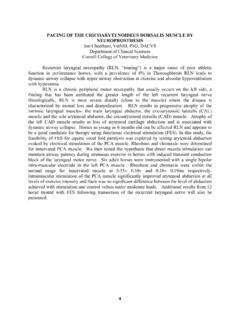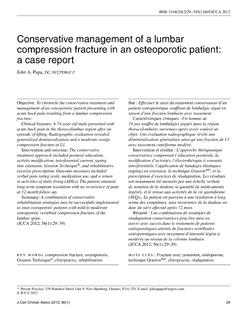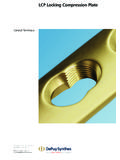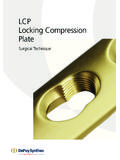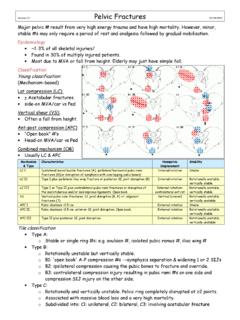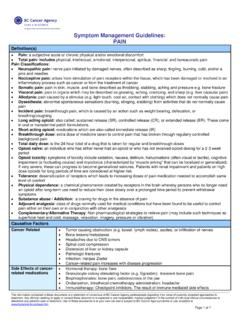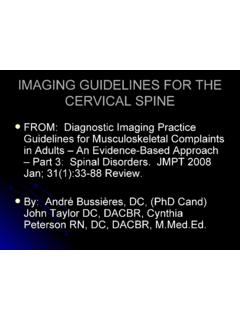Transcription of NONINVASIVE MANAGEMENT OF LONG BONE FRACTURES - …
1 NONINVASIVE MANAGEMENT OF long bone FRACTURES . Jan F. Hawkins, DVM, DACVS. Purdue University It is well recognized that long bone FRACTURES in the horse present unique challenges to the equine surgeon. Closed long bone FRACTURES are the most amenable to internal fixation and have the highest likelihood of a successful outcome. However, open or comminuted FRACTURES managed with internal fixation are predisposed to infection and may ultimately result in nonunion, delayed union, or osteomyelitis. When these complications develop euthanasia is not uncommon. Strategies to manage open, comminuted long bone FRACTURES apart from internal fixation include closed fracture MANAGEMENT with external coaptation combined with transfixation pinning.
2 External coaptation is amenable to a variety of fracture configurations and may be the only practical solution for open, comminuted FRACTURES . In addition to external coaptation combined with transfixation pinning the Anderson rescue sling can be used during fracture healing to minimize the risk for contralateral limb laminitis and decrease weight bearing on the fractured limb. Client communication: Following patient evaluation the pros and cons of internal fixation versus a NONINVASIVE approach are discussed with the client and recommendations are made for definitive treatment.
3 Owners are informed of the prolonged course of treatment required to successfully heal these difficult FRACTURES and the prognosis for athletic use is discussed. Owners are encouraged to accept that athletic use with this type of fracture MANAGEMENT is not likely and that the primary goal of treatment is to save the life of the animal and avoid euthanasia. External coaptation and transfixation pinning: Prior to surgery horses are placed in the Anderson rescue sling for induction of general anesthesia. This minimizes the risk for further fracture disruption during anesthetic induction and makes anesthetic recovery easier because the sling is placed and positioned on the horse before induction.
4 Once on the surgery table and before removal of external limb support, wire(s) are placed in the hoof wall to facilitate limb traction with a come-a- long . Traction is necessary to reduce the fracture and stabilize the limb during transfixation pin placement. Following limb traction the open, fracture site is aseptically prepared for wound debridement as dictated by the degree of wound contamination. Regional limb perfusion is initiated prior to wound debridement as a minimum of 30 minutes is required for limb perfusion. The wound is debrided and lavaged and antimicrobial PMMA impregnanted beads are placed either through the open wound or via a small stab incision.
5 A sterile bandage is then placed around the wound. For adult horses, a minimum of two, mm IMEX positive profile pins are positioned proximal to the fracture . These pins can be placed in the proximal portion of the fractured bone depending on the degree of comminution and the extent of fracture lines in the proximal fragment. If fracture lines extend up the proximal fracture fragment pins are placed in the metaphyseal region of the next bone proximal to the affected bone . If desired, or mm lag screws can be used to stabilize large fracture fragments through stab incisions.
6 To minimize loss of fracture reduction when the horse returns to a standing position one to two transfixation pins can be placed in the bone distal to the fracture . Following transfixation pin placement a fiberglass cast is placed including the pins. Following cast placement PMMA is placed over the ends of the pins to protect the pins and minimize pin migration. To aid in anesthetic recovery and prevent loss of fracture reduction the horse is recovered in the rescue sling. 10. Postoperative care: Horses are administered systemic broad spectrum antimicrobials and anti- inflammatories.
7 If desired regional limb perfusion can be repeated with the horse standing depending on peripheral venous access. Following anesthetic recovery horses are immediately placed in the rescue sling and maintained in the sling until radiographic evidence of fracture callous is present. The transfixation cast is changed as needed (typically every 3-4 weeks). Transfixation pins should not remain in place beyond six weeks because of the risk for severe osteopenia distal to the pins. Pin removal is staged and can be performed without cast removal. As fracture healing progresses the fiberglass cast is replaced with a cast bandage and ultimately with a Robert jones bandage plus or minus a PVC pipe splint.
8 Sling MANAGEMENT : At least once a day the sling is loosened so that thoracic pressure is minimized and some weight bearing is allowed. This is done in an effort to minimize pulmonary edema, compression of the jugular veins, and decrease the risk for pulmonary hemorrhage. Pulmonary hemorrhage has been observed in association with prolonged sling immobilization. In one case treated in our hospital fatal pulmonary hemorrhage occurred secondary to prolonged sling placement. Other complications associated with sling immobilization include jugular vein thrombophelebitis, pressure sores, and muscle atrophy.
9 Open, comminuted long bone FRACTURES can be successfully managed with a combination of external coapation, transfixation pinning, and sling immobilization. This method of fracture MANAGEMENT has allowed us to manage FRACTURES frequently associated with an unsuccessful outcome. However, owners should be educated of the expense and time required to heal these types of FRACTURES . 11.

